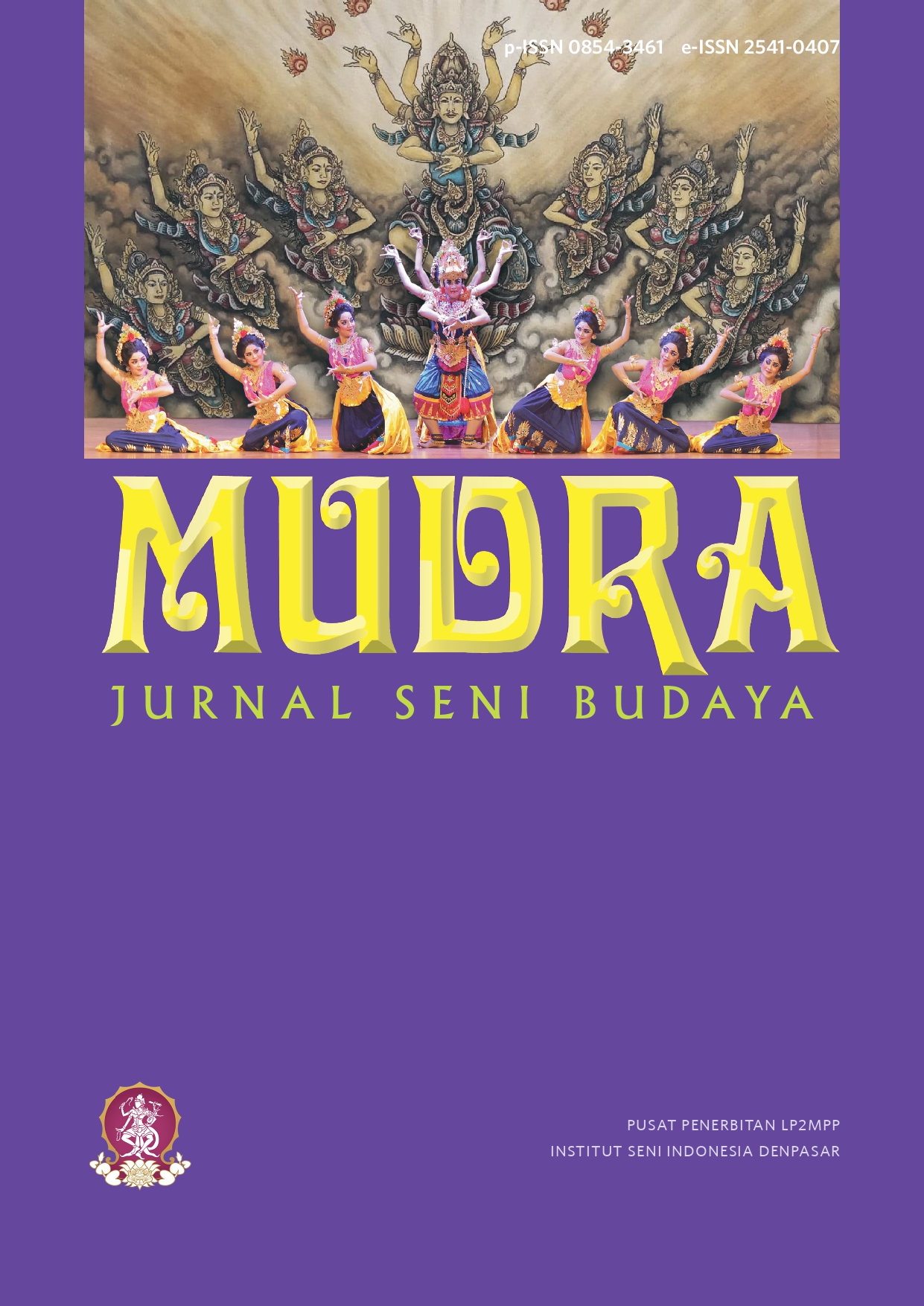Tattoos: Art, Symbol, and History in Dayak Salako
DOI:
https://doi.org/10.31091/mudra.v38i3.2293Keywords:
Dayak Salako, Meaning, Symbol, TattooAbstract
It is the product of qualitative research with a phenomenon approach that covers several stages of observation, deep interview, and documentation. This qualitative work is done in the large Sajingan district, Sambas. The research discussed the phenomenon of tattooing the Dayak Salako people. In the Dayak, tattoos get important attention inside, where the value and meaning behind the tattoo motif adorns the body of the Dayak. The tattoo on the dayak has a long history. Especially the traditional tattoo that is commonly known to the dayak people as the flower of eggplant, it is one of the tattoos in dayak Iban. In Dayak Salako's own well-known tattoos are a form of transcultural interaction with other hackers who have tattoos. Views have also been given to tattoos in which the study includes two types of tattoos found in the Dayak Salako, it has a traditional motif and contemporary tattoos. With the development and progress of knowledge technology regarding tattoos and tattoo meanings transferred to a new meaning to the use of tattoos among the Dayak Salako people. New tattoo motifs emerged that included artistic value, meaning, and viewpoint. The essence of the tattoos used by the dayak Salako people has become an interesting issue because of their many interfaces with the Dayak Iban and their tattoos add to their knowledge of the tattoo.
Downloads
References
Burhan Bungin. (2005). Metodologi Penelitian Kuantitatif. Kencana.
Fakhri, M., & Kahija, Y. F. La. (2015). Menelusuri Kehidupan Pantang Iban: Gambaran Psikologis Manusia Berbudaya Tato Sebuah Interpretative Phenomelogical Analysis. Jurnal Empati, 4(2), 51–57.
Gita, V. (2021). Bahagia hingga Tradisi, Ini 8 Alasan Banyak Orang Memiliki Tato di Tubuh. Liputan6.Com, Jakarta -.
Hudaeri, M. (2010). Debus: Dalam Tradisi Masyarakat Banten (Sholahuddin AL Ayubi (ed.)). FUD PRESS.
Irmayani, T. N. (2015). Pengaruh Tato Terhadap Peningkatan Konsep Diri Pada Wanita Dewasa Awal. 1–86.
Koentjaraningrat. (2016). Beberapa Pokok Antropologi Sosial: Vol. Jakarta (Issue PT. Dian Rakyat).
Leonaldy; Ismunandar; Imma, F. (2015). Motif dayak. Jurnal Pendidikan Dan Pembelajaran Khatulistiwa, 4(9), 1–10.
Marzali, A.-. (2017). Menulis Kajian Literatur. ETNOSIA: Jurnal Etnografi Indonesia, 1(2), 27. https://doi.org/10.31947/etnosia.v1i2.1613
Mustafa, P. S., Gusdiyanto, H., Victoria, A., Masgumelar, N. K., Lestariningsih, N. D., Maslacha, H., Ardiyanto, D., Hutama, H. A., Boru, M. J., Fachrozi, I., Rodriquez, E. I. S., Prasetyo, T. B., & Romadhana, S. (2020). Metodologi Penelitian Kuantitatif, Kualitatif, Dan Penelitian Tindakan Kelas Dalam Pendidikan Olahraga. Program Studi.
Nabila, F. A. (2015). No Title. Liputan6.Com.
Nuriarta, I. W. (2019). Tanda Dan Makna Kartun Politik Koran Jawa Pos Tahun 2019. Mudra Jurnal Seni Budaya, 34(3), 366–371. https://doi.org/10.31091/mudra.v34i3.795
Pradita, M. E. (2013). Tato Sebagai Sebuah Media Komunikasi Non Verbal Suku Dayak Bahau. EJournal Sosiatri-Sosiologi (Fisip-Unmul.Ac.Id), 1(4), 1–15.
Praptantya, D. B., & Listyaningrum, I. (2018). Dialektika Tradisi Pada Komunitas Dayak Bakati’Desa Sebunga Kabupaten Sambas. Proyeksi: Jurnal Ilmu-Ilmu …, 23(2). https://webjurnal.untan.ac.id/index.php/Proyeksi/article/view/2449
Raco, J. R., & Tanod, R. R. H. M. (2012). Metode Fenomenologi Entrepreneurship Aplikasi pada Enterpreneurship. 210.
Raihan, D. (2022). Tradisi Tato Dayak Sebagai Simbol Strata Sosial. 39–44.
Sakulok, E. W. (2018). Makna Tato Sebagai Bentuk Komunikasi Nonverbal Studi Etnografi Tato di Kecamatan Siberut Selatan, Kabupaten Kepulauan Mentawai. Universitas Kristen Indonesia.
Santi, K. (2021). Keberagaman Budaya Antar Suku Dayak-Suku Banjar di Kalimantan. OSF PrePrints.
Sepa, N. W., Bahari, Y., & Fatmawati, F. (2019). Analisis Pergeseran Makna Tato Suku Dayak Iban Pada Generasi Muda Di Desa Batu Lintang. Jurnal Pendidikan Dan …, 1–9. https://jurnal.untan.ac.id/index.php/jpdpb/article/view/34969
Sia, E. F., & Yunanto, T. A. R. (2019). Pemaknaan Dan Konsekuensi Budaya Tato Pada Suku Dayak. Insight: Jurnal Pemikiran Dan Penelitian Psikologi, 15(2), 213. https://doi.org/10.32528/ins.v15i2.1849
Subair, N., & Nur, S. (2022). Nilai sosial budaya dalam pembatasan keturunan. PADARINGAN: Jurnal Pendidikan Sosiologi Antropologi, 4(2), 84–92.
Surachman, A. Y., & Nurdiansyah, D. (2020). Makna Tato Dalam Tradisi Budaya Populer. Prolistik Jurnal Ilmu Komunikasi, 5(April), 57–64.
Susanti, H. D., Arfamaini, R., Sylvia, M., Vianne, A., D, Y. H., D, H. L., Muslimah, M. muslimah, Saletti-cuesta, L., Abraham, C., Sheeran, P., Adiyoso, W., Wilopo, W., Brossard, D., Wood, W., Cialdini, R., Groves, R. M., Chan, D. K. C., Zhang, C. Q., Josefsson, K. W., … Aryanta, I. R. (2017). PESAN KOMUNIKASI NONVERBAL DALAM SENI TATO Disusun. Jurnal Keperawatan. Universitas Muhammadya Malang, 4(1), 724–732.
Tylor, E. B. (2014). Primitive Culture. In Paper Knowledge. Toward a Media History of Documents.
Wekke, I. S. (2019). Metode Penelitian Pendidikan Bahasa (Vol. 53, Issue 9). https://www.researchgate.net/publication/337906625_Metode_Penelitian_Pendidikan_Bahasa
Wibawa, A. P., Santosa, I., & Sabana, S. (2023). Review of Shape and Color on Poleng Motifs in Bali. Mudra Jurnal Seni Budaya, 38(1), 61–72.
Wijayanti, N. (2019). Kesenian Tari Sufi: Studi Nilai Budaya dan Potensinya Sebagai Sumber Pembelajaran Antropologi di MAN 1 Magetan. Gulawentah:Jurnal Studi Sosial, 4(2), 102. https://doi.org/10.25273/gulawentah.v4i2.5557
Zakiah, N. E., Sunaryo, Y., & Amam, A. (2019). Implementasi Pendekatan Kontekstual Pada Model Pembelajaran Berbasis Masalah Berdasarkan Langkah-Langkah Polya. Teorema: Teori Dan Riset Matematika, 4(2), 111. https://doi.org/10.25157/teorema.v4i2.2706
Zulaihah, S. (2021). Buku Ajar Pengantar Ilmu Antropologi. Buku Ajar Pengantar Ilmu Antropologi, 1–71.
Downloads
Published
How to Cite
Issue
Section
License
Copyright (c) 2023 Cornelius Kiki Hartanto, Donatianus BSE. Praptantya; Diaz Restu Darmawan; Ita Lusia, Devi Fridayanti

This work is licensed under a Creative Commons Attribution-NonCommercial-ShareAlike 4.0 International License.
- Copyright on any open access article in a journal published by Mudra Jurnal Seni Budaya is retained by the author(s).
-
The Creative Commons Attribution License 4.0 formalizes these and other terms and conditions of publishing articles.






